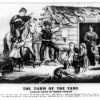calsfoundation@cals.org
Operabilly
2013 April Fools' Day Entry
Operabilly is a genre of music unique to the Ozark Mountains of northwestern Arkansas. The term “operabilly” is a compound of “opera” and “hillbilly,” thus indicating a fusion of traditional operatic elements and themes with the motifs and musical sensibilities of Ozark Mountain dwellers. Its foothold in Arkansas’s rich musical history includes performances of My Damn Butterfly and the controversial naming of a stretch of Arkansas highway the highfalutin “Opera Highway 23,” rather than the more accurate “Operabilly Highway 23.”
While there have long been so-called “hillbilly opera” productions, these have primarily been comedy productions lampooning the people of Appalachia and the Ozarks through a contrast of low, hillbilly culture with the highbrow word “opera.” True operabilly, by contrast, preserves both opera’s traditional dramatic narrative (libretto) and its musical score, as well as the theatrical setting for performances. However, these are infused with a honky-tonk aesthetic, along with elements of bluegrass music.
Operabilly really got its start in the 1950s. During the early part of that decade, the University of Arkansas (UA) in Fayetteville (Washington County) was experiencing a surge in enrollment. Not only was rock and roll growing in popularity nationally, but many of the students attending this university came from the Delta region of the state and brought with them a love of blues music, leading to the development of a dynamic music scene in Fayetteville. At the same time, opera and classical music were undergoing a regional revival. The university’s music department was growing and becoming more professional, and the Inspiration Point Fine Arts Colony in Eureka Springs (Carroll County), predecessor to what is now Opera in the Ozarks at Inspiration Point, held its first session in the summer of 1950, giving rise to fairly regular operatic performances. Student musical groups with a foot in both the classical and popular musical worlds probably oversaw the synthesis of these genres into what is now known as operabilly.
The earliest days of operabilly are poorly documented, though oral histories have confirmed that many productions took place in local juke joints, typically on weekdays, when the usual clientele would not be present. By the early 1960s, however, operabilly was being performed on campus by student groups and was beginning to draw an audience, especially from those usually turned off by the foreign language and melodramatic plots of most well-known operas. The most popular operabilly production was The Big Shootout, a dramatic interpretation of the legendary 1969 football game in which the Razorbacks lost by one point to the Texas Longhorns. The April 1, 1970, performance at the Chi Omega Greek Theater on the UA campus attracted thousands of spectators and included such well-known opera tropes as a buxom lady finishing the show with a twenty-minute aria; however, in this case, she was sporting a Texas Longhorns cap, rather than the traditional horned helmet. As historian Michael B. Dougan has written, “Only a sourpuss Razorback fan could see anything comparable between a lost football game and Wagner’s Twilight of the Gods. Götterdämmerung, indeed.”
While most classical opera is produced in the original language, usually Italian, French, or German, even for audiences who do not understand it, few works of operabilly are written in a foreign language. The one notable exception is Il Barbiere de Lato Soleggiato, which was written in Italian and first performed in 1987 using people from the community of Tontitown (Washington County), many of whom retain a connection to their Italian heritage. However, other works have coyly referenced classical opera in titles and plot, such as My Damn Butterfly or The Magic Boot, the latter of which loosely follows the plot of Wolfgang Amadeus Mozart’s The Magic Flute, though set in the American West.
Operabilly’s popularity has waxed and waned locally, but even though the musical genre has never gained a national footing, it still has a core group of devotees within the state, with regular performances being conducted in Fayetteville, Bentonville (Benton County), and at Opera in the Ozarks at Inspiration Point in Eureka Springs.
In 2011, an approximately fifty-four-mile segment of U.S. Highway 23 running from Rogers (Benton County) to Green Forest (Carroll County) was designated Opera Highway 23 by the Arkansas General Assembly. There was a modicum of controversy over the name, with many local scholars insisting that naming the roadway the “Opera Highway” rather than the “Operabilly Highway” misrepresented the form of music that was performed in the area, but many regional legislators, seeking to remove from the area the stigma of hillbilly culture, especially in advance of the November 2011 opening of the Crystal Bridges Museum of Art, refused to reconsider the name.
April Fools!
For additional information:
Dougan, Michael B. “A Rustic Cavalry, Indeed: The Emergence of Operabilly in Arkansas’s Northwestern Corner.” Arkansas Historical Quarterly 52 (Spring 1993): 42–79.
Opera in the Ozarks at Inspiration Point. http://opera.org/ (accessed November 3, 2021).
Maria Anna Josepha Francisca Gottlieb
Vilonia, Arkansas
 Arts, Culture, and Entertainment
Arts, Culture, and Entertainment Classical Music and Opera
Classical Music and Opera Divergent Prosperity and the Arc of Reform, 1968–2022
Divergent Prosperity and the Arc of Reform, 1968–2022 Music and Musicians
Music and Musicians Operabilly Performance
Operabilly Performance 




Comments
No comments on this entry yet.